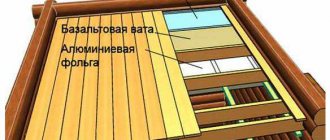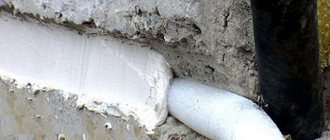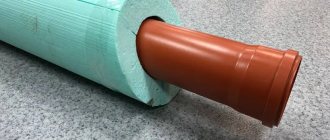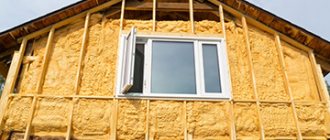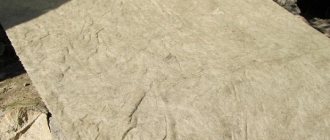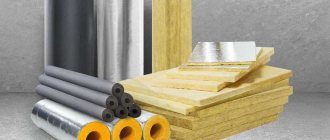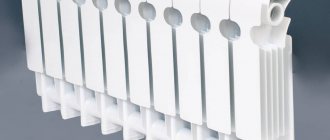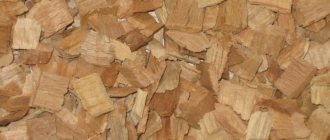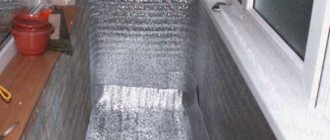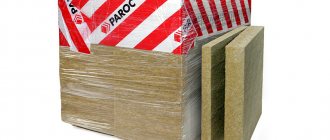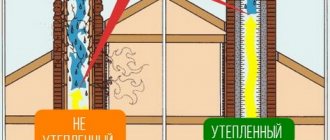Installation of sheathing
Before installing fiber cement siding, it is necessary to create a frame on which the panels will be attached.
Stages of frame production:
- Fixation of the drainage system on the façade – drainage pipe, gutter
- Attaching a waterproofing film to the wall of a building with self-tapping screws
- Installation of sheathing from boards - usually a wooden beam with a cross-section of 5 centimeters is used, installing guide vertical slats with a pitch that will be equal to the size of the slab (if insulation is needed, then a layer of insulation is laid between the beams)
- Fastening the second layer of waterproofing with slats
- Installation of vertical sheathing, which will become the basis for siding: wooden beams with a cross-section of 3 centimeters are attached to the insulation frame
Insulation from above
Insulation implies various methods of attaching insulation. Today two types are known:
- Upper.
- Lower.
The upper one provides for insulation from the attic of the house, which is quite relevant for private houses. The process includes a sequence of actions such as:
- The first step is to attach the beams to the beams.
- Laying insulation.
- After which the insulation material itself is laid directly.
- The final step is the cladding. You can use a board for it. This is done to allow free movement around the perimeter of the attic.
The advantage is that you can use any type of insulation, even in bulk form, such as expanded clay. An important feature that you should pay attention to when laying is that during the process itself it is very important not to leave empty space.
Regardless of the method, for installation you will need tools such as:
- Knife or hacksaw.
- Nails.
Nails and screws - Various screws.
- Hammer.
- Bulgarian.
- Electric drill.
- A stapler designed specifically for construction work.
- Polyurethane foam.
- Profiles.
- Screwdriver.
- Self-tapping screws.
- Dowels.
Insulating the ceiling from the outside
Now we need to move on to a description of the insulation of the ceiling from the outside. This is the advantage that owners of individual housing have over residents of high-rise buildings. Any material can be used as insulation, but the most popular of them are expanded clay, mineral wool and polystyrene foam.
Expanded clay can simply be poured onto the ceiling if the attic is not used in any way. However, in most cases, the attic space is intensively used, so expanded clay is poured between the joists, onto which the flooring is subsequently attached. Insulation of the ceiling from the outside must be accompanied by its waterproofing, which is laid on the ceiling. The vapor barrier membrane must allow steam escaping from the room to pass through and prevent moisture from penetrating inside. The film strips are overlapped. The edges of adjacent sheets should overlap each other by 10-15 cm.
The beams are attached to the concrete ceiling with anchor bolts. The length of the fasteners is selected in accordance with the dimensions of the bars. The fastening step is 1 m. The beams are installed according to the level. If necessary, plywood or wood pads are placed under the joists. The height of the sheathing does not have to be equal to the thickness of the insulation. Its level may be below the upper edges of the lag. After filling the expanded clay, the insulation is covered with waterproofing and boards or flooring slabs, screwed to the joists with self-tapping screws.
Laying expanded polystyrene and mineral wool can be carried out without attaching insulation to the ceiling. The main thing is to lay the insulation more tightly. Insulators are laid on a vapor-permeable membrane between the beams of the sheathing. After this, the thermal insulation is covered with another film and floor boards.
Dried sawdust can also be used as external ceiling insulation. However, they will not improve the level of fire protection at home at all.
Insulation from below
This type involves the process itself directly from the bottom of the ceiling itself. Materials made in rolls or beams are ideal for it.
This method is considered more difficult and labor-intensive. The process itself includes the following stages of work:
- It is necessary to make the fastening using hemming. If this was not possible, you can build up beams on which the installation will be carried out in the future. If it is done using foam plastic, then the process itself is greatly simplified. It can simply be glued to the ceiling. But after this, to increase reliability, it should be additionally secured with dowels intended for these types of work. After the installation process, the ceiling itself, if its condition requires it, can be decorated by painting or using putty.
Thus, you can carry out the fastening with your own hands. The main criterion is the presence of either a suspended frame or specially made fastenings.
If the ceiling height is low, it is better to opt for foil-coated polyethylene foam. The profiles on which they will subsequently be attached can be made of metal or wood. After insulation is completed, if desired, the ceiling can be decorated in various ways, the main ones being painting or installing a stretch ceiling.
Today there is a huge selection of insulation materials that can not only retain heat in your home, but also provide good sound insulation, which is quite important in multi-story panel or brick houses.
- Date: 02/05/2015 Comments: Rating: 15
Warmth and comfort in the home are one of the first tasks that need to be solved for a comfortable life and preservation of health. In the modern world, where the daily rise in price of energy resources is by no means new, the issue of insulating living quarters is acute.
Scheme of insulation and soundproofing of a wooden ceiling.
To ensure the safety of heat from below, “warm floors” are used; to prevent it from escaping through walls and windows, plastic structures are used.
But it is extremely important to pay attention to heat loss through the ceiling. This is due to the fact that more than 30% of all heat is concentrated at the top of the room. If adequate thermal insulation is not maintained, this will inevitably lead to condensation settling, an increase in the amount of moisture and, as a result, the formation of mold.
How to avoid this, you ask? Is it possible to insulate a ceiling with your own hands?
Of course. In addition, it is quite simple to do, without spending a large amount of effort and material investments. You just need to properly understand the question of how to attach the insulation to the ceiling?
Before considering the issue of attaching insulation to the ceiling, you should pay attention to such an important aspect as the types of insulation. What is the material with which you will insulate your ceiling? After all, only after deciding on this issue, you can purchase it and start mounting it.
What is the best way to insulate a ceiling?
When choosing insulation for a ceiling located under a cold roof, you should take into account regulatory fire safety requirements. The fact is that for all types of floors these requirements are quite stringent, which makes it impossible to use combustible materials for thermal insulation. To put it briefly and in simple words, the insulation layer should not reduce the standard fire resistance of the structure. That is, ceilings under a cold attic, hemmed to wooden beams, as well as interfloor wooden floors and the same ceilings above the basement cannot be insulated with flammable materials.
Accordingly, the answer to the frequently asked question, whether it is possible to insulate the ceiling with foam plastic from the inside over wooden beams, is quite clear - it is not possible. This also applies to the use of extruded polystyrene foam and penoplex. It turns out that the list of insulation materials suitable for thermal insulation of wooden structures is quite limited:
- non-flammable basalt (stone) wool, sold in slabs and rolls;
- bulk fire-resistant insulation – expanded clay, perlite;
- traditional folk material - sawdust mixed with clay.
Mineral wool made from fiberglass is not suitable, as it can withstand temperatures no higher than 200 °C. The same applies to actively advertised ecowool. Although it does not burn, ecowool cannot serve as both ceiling insulation and a fire barrier. Judging by the degree of popularity among homeowners, the best insulation option in this case is basalt mineral wool. The other listed materials have too high thermal conductivity in comparison.
To glue or not to glue
Air movement under mineral wool slabs reduces the thermal insulation properties of the material. Since when insulating a facade, fastening without movement is possible only with the help of glue, dowels are used as additional fixation .
In addition, mineral wool adhesive helps save on room insulation. The consumption of the mixtures is insignificant, since they can not be applied over the entire area of the slab .
It is important to remember that the remaining adhesive solution cannot be stored in the container. The mixture should be used immediately after preparation.
Ceiling insulation with mineral wool
Tools needed when working on room insulation.
The question arises: isn’t it difficult to install insulation on the ceiling in an apartment if you can only use mineral wool? However, it is produced not only in rolls or sheets, but also in slabs. The latter has increased characteristics of moisture resistance, density and fire safety. Its fastening is done in almost the same way as installing foam insulation. But laying roll insulation is not as complicated as it might seem at first glance.
Before laying soft mineral wool under the ceiling, it is necessary to create a sheathing hemmed to the ceiling. But first you need to clean the insulated surface from whitewash or water-based paint, treat the ceiling with waterproofing impregnations and primer. This will improve the adhesion of the insulation to it.
How to make a sheathing?
To attach the sheathing to the ceiling, you need to build its plane. For this you will need:
- level;
- roulette;
- painting cord;
- chalk;
- synthetic threads;
- self-tapping screws
Scheme of ceiling insulation with mineral wool.
At a certain distance from the ceiling, corresponding to the thickness of the insulator, a point is placed on the wall. Using a level, marks are made on the remaining walls. Horizontal lines are drawn between adjacent points on each wall using a cord, rubbed chalk or plaster. Self-tapping screws are screwed into the walls along them, between which threads are stretched, forming the plane of the new ceiling. The profile or bars are hemmed to the concrete ceiling using corners and dowel-nails. The step between fasteners should not exceed 60 cm. The distance between adjacent bars should be slightly smaller than the width of the roll or sheet of mineral wool. This will allow the insulation to be tightly inserted between the slats.
Laying the insulator
The ceiling between the guide rails is coated with glue, after which insulation is laid. After laying, a vapor barrier membrane is attached to the sheathing with a stapler. Additional adhesion of the insulation to the ceiling is provided by disc-shaped dowels, the length of which must be at least 50 mm greater than the thickness of the insulation. For every square meter of mineral wool laying there should be at least 5 dowels. After completion of the work, the sheathing is sheathed with a finishing coating.
Scheme of insulation of walls indoors.
Mineral wool in slabs (basalt slabs) can be mounted under the ceiling without lathing. Before installation, the ceiling is cleaned of old coating, dust, grease stains, etc. The surface is impregnated with waterproofing agents and primer. After this, glue is applied to the ceiling. You should not apply it to the entire floor at once unless you are sure that you will finish the work before the prepared mixture dries.
The glue is also applied to the slab. After that, she presses herself against the ceiling for a few seconds. The remaining panels are glued in the same way. They are located close to each other. Insulation of the ceiling with fragments of tiles is carried out only after laying whole slabs. The panels are fixed with disc dowels (5 pieces for each slab). After this, glue is applied to the mineral wool, to which the synthetic mesh is pressed. The glue is evenly distributed with a spatula over the surface. After two days, the ceiling can be puttied with regular putty and finished with finishing coatings.
https://youtube.com/watch?v=_opRoRWXWLI
Attaching the insulation from below
If there is no access to the outside of the ceiling, you will have to act from the inside. And here a reasonable question immediately arises: how to fix the insulation to the ceiling? There is no definite answer to this, because it depends on the type of insulation and on what decorative ceiling finish you have chosen.
Let's consider all the methods.
Insulation with decorative materials
We are talking about gluing decorative tiles made of polystyrene foam or expanded polystyrene to the ceiling. This is the simplest, but at the same time ineffective method.
Photo of a tiled ceiling
However, if you carefully seal all the cracks and joints between the slabs, putty the ceiling, and then finish it this way, the house will become a little warmer. In addition, it is perhaps the only one that “steals” only a few millimeters of height from the room.
Insulation with slab materials
These include polystyrene foam, penoplex and other similar insulation materials produced in the form of rigid slabs. If you are deciding how to insulate the ceiling in order to get maximum effect at minimal cost, then this is your option.
It has the following advantages:
- Penoplex is not afraid of moisture and does not become a breeding ground for mold;
The material does not absorb moisture
- It has excellent heat-saving characteristics;
- The rigid, shape-retaining material is easy to work with;
- Fastening requires only glue and a small number of special plastic dowels;
- The high density of the material allows you to apply putty on it, which, together with whitewashing or painting, is one of the most cost-effective ways to decorate the ceiling.
Fastening technology:
| Image | Description |
| Glue or polyurethane foam is applied to the back side of the slab along its perimeter and in the center. |
| The material is pressed against the ceiling and held until the glue sets on the base. |
| For additional fixation, holes for dowels are drilled in the ceiling directly through the insulation. Five points are enough: in the corners and in the center. |
| Dowels with wide heads are driven into the holes. All joints are sealed with polyurethane foam. |
It is important! Regardless of the material and method of insulation, the base is prepared before starting work so that it is clean, dry and free of signs of mold. It is also recommended to treat it with antifungal compounds.
This work is easy to do with your own hands, saving also on paying hired workers. But subsequent puttying with fiberglass mesh reinforcement is a rather complicated matter; in the absence of experience, it is better to entrust it to specialists.
Plaster on insulation
Insulation with roll materials
The main disadvantages of polystyrene foam are flammability and impermeability to air. Therefore, when deciding how best to insulate the ceiling in residential premises, preference is often given to “breathable” stone wool and similar analogues - ecowool, glass wool.
It is produced both in the form of slabs and in rolls. To insulate the ceiling, you can use special facade slabs in a rigid shell, which are attached in a similar way to foam plastic.
Basalt thermal insulation
This method is not suitable for soft fibrous materials. Therefore, thermal insulation with mineral wool is combined with the installation of suspended ceilings. In this case, it is necessary to take care of the waterproofing of the insulation, which readily absorbs moisture.
Without dwelling in detail on the technology of constructing the frame, we will describe how the installation of this material occurs.
| Image | Description |
| After waterproofing the base, a wooden or metal frame is assembled on the ceiling. |
| Depending on the release form, mineral wool is rolled out in the space between the frame and the ceiling or inserted into cells. The technology is the same as for insulation from above - with displacement and sealing of joints. |
| A vapor barrier material is spread over the insulation, with mandatory gluing of the seams at the joints. Next, to create an air gap, bars are packed onto the wooden frame, to which the cladding will be attached. |
Advice. To prevent the insulation from sagging under its own weight, it can also be secured with umbrella dowels. Another option is to stretch wire between the frame guides.
Fixing the position of the insulation with a tensioned wire
There is another type of roll insulation based on foamed polyethylene. It’s even easier with it: it is nailed or screwed to the ceiling through or through the sheathing slats.
Work technology
It is very important that the roof of the house is warm. It's not cheap, but it saves your budget in the future.
After all, energy costs are significantly reduced.
When working on ceiling insulation with expanded clay, the weight of the material itself is of great importance. Due to the weight of expanded clay, it cannot be used in the presence of wood floors. Due to the heaviness of the material, the decking may completely collapse. Expanded clay should be used in the presence of concrete floors. The insulation scheme for the ceiling and roof may vary slightly.
If there is old insulation, it is best to remove it too. It can create unnecessary load on the floors.
The next step is to carry out thorough isolation. This is necessary so that in the spring you do not have to remove the consequences of flooding. A special membrane is used for this. It is placed between the joists so that about four centimeters are screwed onto the sides of the joists.
The insulator must be pressed very tightly against the joists. It is usually fixed with a stapler or glue.
The wooden floor must have oxygen access on at least two sides.
After this, laying of the first layer of insulation begins. It is placed up to the joist level. Then the insulation is covered with a membrane, which has a low oxygen permeability. Then the wood flooring is laid. Special gaps are left for ventilation.
In this case, it is worth considering the waterproofing layer. Often builders use material about fifty millimeters thick.
When carrying out insulation using polyurethane foam, you will need to call a specialist. The spraying process occurs under high pressure. Due to this, all the cracks are filled. The thickness of the layer is from ten to twelve centimeters.
Mineral wool as insulation has different thicknesses. Indicators depend on the volume of work. The layer of wool used as insulation can range from two to twenty centimeters.
The thickness of this material ranges from one millimeter to two centimeters. Polystyrene foam is laid in slabs. The thickness of one slab varies from two to ten centimeters. This happens because the material needs to be overlapped.
When insulating an attic, various materials are used for insulation. But the average ranges from fifteen to twenty centimeters. The layer of clay and straw is approximately ten centimeters. To ensure that everything is straight, you should use a special ruler or stick.
Styrofoam
Externally, polystyrene foam has much in common with foamed plastic material, which has a cellular structure. Typically this insulation is produced in sizes of one by one meter. It is used when internal and external fastening of thermal insulation to the ceiling is carried out.
The thickness of the foam varies from 20 to 100 centimeters, which depends on the type of finish. The material can be used as a base for puttying the ceiling surface. Another area of application of polystyrene foam is its use to level the ceiling plane.
Polyfoam is easy to use and has a number of advantages:
- is a universal material;
- low cost makes it more accessible to many consumers;
- durability;
- provides a high degree of room protection;
- has a good level of thermal insulation.
Insulation of ceilings in a house with mineral wool
Mineral wool is a fibrous heat insulator produced in the form of rolls or slabs. The composition of the material is determined by GOST R 52953-2008, and there are three types of mineral wool - stone, slag and glass (better known as glass wool). Let's take a closer look at them.
Prices for mineral wool
mineral wool
Stone wool is made from various rocks, such as diabase or gabbro, and also contains clay, limestone, dolomite and a binder containing formaldehyde resins. The average thermal conductivity coefficient of stone wool is 0.08-0.12 W/(mK). In our case, the lower its value, the more suitable the material is for the role of insulation.
Unlike stone, slag wool is made from blast furnace slag and other metallurgical waste. The thermal conductivity coefficient averages 0.47 W/(mK), which, combined with its high hygroscopicity (the ability to absorb moisture), makes slag wool an unsuitable material for insulating ceilings. In addition, it has residual acidity, so it should be kept away from metal pipes, beams and other products.
Slag
Glass wool ranks first in terms of thermal insulation quality among mineral wools - 0.03 W/(mK). It is also distinguished by a very low price. The disadvantages include the fact that particles of this material can cause harm to humans if they get on the skin, eyes or lungs. But this is, to one degree or another, characteristic of all types of mineral wool, therefore, when working with them, it is necessary to wear gloves, safety glasses, a respirator mask and closed work clothes.
The main advantage of all types of mineral wool is that this material is very convenient for transportation, carrying and installation, as it is light in weight. In addition, it is non-flammable and at very high temperatures can only sinter (while losing its thermal insulation properties)
And it is especially important for country houses that mineral wool is not an attractive place for rodents, insects, fungi or mold
The most famous manufacturers of this material are Ursa and Paroc
If quality is important to you, then when going to a hardware store, look for mineral wool from these companies
When choosing, also pay attention to the density of the material - the ceiling may not withstand samples of mineral wool that are too dense and heavy
The insulation process should begin by determining the area of the ceiling, because first you need to calculate how much mineral wool, vapor and waterproofing films you will need. Next, the technology of external ceiling insulation will be considered. If you require internal insulation, follow the same instructions, but swap the layers of hydro- and vapor barrier.
Glass wool prices
glass wool
Calculation of ceiling area
In addition to the insulation itself, you will need wooden boards or a metal profile, tools for cutting mineral wool, protective clothing and equipment (gloves, a respirator and goggles) and fasteners.
- First, we lay a vapor barrier film on the floor of the attic, making sure that there are no breaks in it. The laying should be overlapped, the seams should be taped with special vapor barrier tape.
- On top of it we install a lathing made of wood or galvanized profile. The distance between the slats should be several - a couple of centimeters - less than the width of the sheet or roll of mineral wool. This way the insulation will fit more tightly. The height of the lathing should exceed the thickness of the thermal insulation layer by 1-2 centimeters in order to subsequently ensure air circulation between it and the waterproofing.
- We unpack the mineral wool and place it in the space between the slats. If the material is laid in several layers, the next layer should overlap the seams of the previous one.
- We attach the waterproofing to the sheathing on top using a furniture stapler. In this case, as mentioned above, there should be a small space between it and the mineral wool for air circulation.
External ceiling insulation with mineral wool
Advantages of mineral insulation
Why do most people choose mineral wool? This is explained by the fact that this insulation has more advantages than disadvantages. Positive qualities of mineral wool include:
- Affordable price;
- Convenient use;
- Not afraid of pests (mice and rats);
- Does not rot or mold;
- Fireproof material;
- Has soundproofing properties;
- Good vapor permeability;
- Environmentally friendly material;
- Has increased strength;
- The thickness of mineral wool may vary.
Because of these qualities, mineral wool is the optimal material for ceiling insulation. But, like any material, it has its drawbacks:
- It must not be crushed or compacted. This reduces its thermal insulation properties;
- Mineral wool is afraid of moisture. When wet, it completely loses its properties.
This type of insulation is used in combination with other materials - polystyrene foam and polyethylene film. Thermal insulation with this design will be reliable.
How to insulate?
In order to insulate a room inside, several types of materials are used. Most often, a special heat-insulating material is used, which is called glassine. It has the following advantages:
- economically beneficial;
- practical;
- resistant to temperature changes;
- resists moisture well.
Insulation materials with similar characteristics are also popular. These include the following:
- nenofol;
- expanded polystyrene;
- isolon;
- penoplex;
- technical wool;
- cork.
7 photos
PVC film is most often used as waterproofing, which reliably protects against leaks. Its service life is several decades. It is profitable to use film, because it is inexpensive.
Drywall
Drywall is good because it provides a perfectly flat surface without seams; it can be used to create any type of ceiling. To work with drywall, two types of lathing are used:
- made of wood - it is easier to work with such material, it costs less;
- made of galvanized profile - is more durable, does not deteriorate under the influence of temperature changes, and is not susceptible to mold or mildew.
Technical wool
Ceiling insulation in a private household using technical wool is carried out in the following way:
- using a stapler, a PVC film is mounted to the ceiling, which will reliably protect against moisture getting on the slabs;
- the lathing is made of wooden blocks in increments of 40–50 cm. The size of the block must correspond to the thickness of the thermal plates, that is, it must be 5 cm;
- slabs of technical wool are laid and secured with special mounting rails. This design is reliable and simple, not subject to deformation.
Mineral wool has several important characteristics.
- Low thermal conductivity - 0.036 W/ (m*K); for insulation, a layer of no more than 10 cm is sufficient, which corresponds to the usual thickness of load-bearing beams.
- The material has increased vapor permeability; for 50 kg of weight per cubic meter the coefficient is 0.7 mg/ (m*h*Pa). This figure is higher than that of wood.
- Slight hygroscopicity, that is, upon contact with liquid, the material will absorb no more than 2% of moisture from the total volume.
- Mineral wool slabs have high fire safety. Such insulation is non-flammable and does not contribute to the spread of fire.
- Mineral wool has good soundproofing characteristics and is capable of effectively blocking sound waves of various frequencies. It is especially beneficial to use basalt insulation, because it does not deform and has a long service life. One package is enough to treat about twenty square meters.
- The material is not susceptible to the harmful effects of fungus or mold, and has antiseptic properties.
- The porous material, which has a low specific weight, cannot be burdensome for supporting structures, which contributes to a long service life.
Condensation has a detrimental effect on industrial wool; it inevitably loses its beneficial properties. PVC slabs are not afraid of moisture and are not subject to erosion or the spread of fungus. The advantages of mineral wool are that it is not afraid of moisture and does not become damp. Mineral wool is cheaper than PVC boards, does not contain toxins, foam boards emit harmful components.
Insulation of the ceiling with mineral wool from the inside and outside - choice of material and installation features
Insulating the ceiling with mineral wool is a good way to make your home warmer, improve comfort and reduce heating costs. Mineral wool is an environmentally friendly material and has undeniable advantages: low thermal conductivity and excellent heat-saving abilities.
Mineral wool consists of thin glassy fibers, between which air pores are formed, constituting 95% of the volume of the entire material. This is what gives mineral wool such exceptional thermal insulation properties.
Manufacturers produce mineral wool: in the form of slabs and rolls. Both slabs and rolls allow you to create a continuous layer without gaps.
For long-term and trouble-free operation of mineral wool, it is necessary to take care of reliable protection from moisture. The effectiveness of this insulation material decreases by several orders of magnitude even when a minimal amount of liquid gets in. And completely wet cotton wool is practically useless. Installing a hydro and vapor barrier will help protect against moisture.
When using foil plates, insulation is ideal: they retain heat well and reflect back thermal infrared radiation.
Benefits of mineral wool
Mineral wool has many advantages over other insulation materials:
- Low thermal conductivity coefficient.
- Excellent soundproofing characteristics.
- Air conductivity. This property allows the use of mineral wool for insulation in wooden houses.
- Wide operating temperature range.
- Light weight, easy handling and quick installation.
- Non-flammability: does not emit toxic substances in case of fire.
- Modern types of mineral wool are resistant to water; when wet, they dry quickly and restore their properties.
- Resistant to chemical and biological influences.
- Elasticity: after compression several times, it quickly restores its original volume.
- Environmental Safety.
Varieties of mineral wool
Mineral wool, depending on the material of manufacture, comes in three types:
Glass wool is popular because it has the lowest cost. Quartz sand or cullet is used in production. Therefore, glass wool contains small glass fibers that are harmful to human health. Today, glass wool is practically not used for indoor insulation. Most often used for thermal insulation outside the room.
In the production of slag wool, waste from blast furnace metallurgy is used. It contains brittle and thorny fibers that adversely affect human health. Of all types, it has the lowest thermal conductivity. It absorbs moisture well, but is short-lived: its service life is no more than 15 years. Of the advantages of this material, only one can be named - low price.
Basalt mineral wool has unique technical characteristics. Molten basalt is used in production. This is a material of volcanic rocks that has technical characteristics valuable for insulation. Basalt mineral wool is rightfully considered the best thermal insulation material for insulation. This insulation can be used both outside and indoors.
To achieve high-quality and maximum insulation, it is recommended to choose insulation material from well-established and well-known manufacturers.
Features of installation of mineral wool
Modern types of mineral wool are completely safe and do not emit any harmful substances during operation. But during installation you must follow certain rules.
With any type of mineral wool, microscopic fibers are separated during installation. They can get into a person's eyes and lungs, and penetrate under clothing. Glass wool is especially harmful to health, since the smallest glass needles do not dissolve in the lungs and can provoke the development of complex pulmonary diseases.
Therefore, it is recommended to work with mineral wool in a closed suit, gloves, goggles and a respirator. At the end of the work, you need to take a shower, throw away your clothes or wash them thoroughly.
Options for insulating the ceiling with mineral wool
There are two insulation options:
Most often it is performed in cases where it is not possible to insulate the attic or when the ceilings of the room are sufficiently high. Depending on the roof structure, temperature changes and the type of mineral wool, the thickness of the insulation will be from 15 to 40 cm.
Warm ceiling using mineral wool
This material is divided into glass wool, ceramic, slag and stone wool. Varieties of glass wool are modern insulation materials Rocklight, Technoblock, Technovent, Technolight, Technoruf, Technofas, etc. The raw materials for the production of the material are basalt, limestone, diabase or dolomite. The highest quality mineral wool is obtained from rocks.
When using mineral wool, you must wear work clothes, safety glasses and a respirator, because particles of the material irritate the skin. After installation, mineral wool becomes safe for humans. Before using it, it is necessary to clean the surface from debris and dirt to the state of clean concrete. The frame for the future floor is made from wooden beams. Measurements are taken, logs are installed, a vapor barrier is laid, preferably glassine. Sheets of mineral wool are placed on top of it, but this should not be done too tightly; the wool should not be compressed. To make the floor even warmer, you can lay mineral wool in two layers, with the top layer covering the joints of the bottom one. Next, the flooring is laid, which is attached to the wooden frame.
Flaws:
- the material cannot be removed and compacted, because it may lose its thermal insulation properties
- mineral wool must be carefully protected from moisture
- even a small gap can reduce the thermal capacity of the ceiling
- Along with mineral wool, other moisture-proofing material is used, which increases the cost and complicates the process
- needs to be changed every 10-15 years
Mineral wool installation technology
To purchase protective clothing and glasses you will need the following:
- insulation
- wooden slats (width 150 mm, thickness 30 mm) or galvanized profile
- hammer drill
- self-tapping screws
- large scissors
- protective equipment
- vapor barrier
- metal staples
- roulette
If the house is wooden, then wooden slats are chosen as the supporting structure. A waterproofing layer with an overlap of 10 cm is placed on the wooden floor. A sheathing is attached to the top. The distance between the slats is 50−60 cm. Mineral wool is unpacked immediately before installation. The insulation is cut into pieces to a width corresponding to the distance between the slats plus 2 cm for a tight fit.
A gap of 1-2 cm is made between the waterproofing and the insulation for natural air circulation. Mineral wool is placed tightly enough so that no folds or crevices form. Then a vapor barrier is attached on top perpendicular to the rafters with an overlap of 10 cm and attached to the wooden slats using a stapler. All seams are carefully secured with mounting film. This will strengthen the tightness of the structure.
Glue option
Everything will be much simpler here. There is no need to assemble the sheathing or frame - all the slabs are simply glued to the base and then further strengthened using plastic dowels. However, before starting work, it is imperative to prime the ceiling and, if necessary, create a waterproofing layer.
The glue must be spread both on the surface and on the slab. Some adhesive compositions can only be applied to the part being glued - be sure to clarify this point in the instructions for the glue. When all the slabs are glued and secured with dowels, they proceed to the final stage - covering the mineral wool with non-woven fabric, vapor barrier or polymer mesh.
A vapor barrier or non-woven fabric prevents cotton wool particles from getting into the air. If they come into contact with the skin, they can cause itching and other unpleasant sensations, and if they get into the lungs they can pose a certain threat to health. That is why all work with mineral wool must be done in a respirator and gloves. The mesh is glued to the surface of mineral wool slabs so that the surface can later be plastered or puttied, and also protects the air in the room from the appearance of insulation particles in it.
How to properly insulate the ceiling in a house with sawdust
When the ceiling is insulated with sawdust, the house turns out to be warm and environmentally friendly. For this process, well-dried clean sawdust of medium or large size is purchased. Sheet or rolled parchment is used on the bottom. Lime and copper sulfate are used as an antiseptic and protection against rodents. The average insulation layer for a wooden house, bathhouse or cottage is 25 cm.
To prepare insulation with your own hands, take:
- 10 buckets of sawdust;
- bucket of lime,
- 250 grams of copper sulfate;
- bucket of cement;
- 10 liters of water.
Lime and copper sulfate are mixed with dry cement. The mixture is poured into sawdust and kneaded, then water is slowly poured in. The resulting mixture should form a homogeneous dense structure.
The chimney is insulated with fire-resistant material, and the wiring is covered with a metal pipe. The parchment is spread out, then the sawdust mixture is filled in and compacted. Afterwards this flooring is left to dry for 2 weeks.
How to insulate the ceiling in a wooden house with expanded clay
Expanded clay is environmentally friendly, fireproof, does not rot and is not exposed to various temperatures.
Expanded clay does not harbor rodents, which is important for owners of wooden houses. Steam and waterproofing are spread in the upper part of the ceiling. The pipe and wiring are insulated with fireproof materials (sheet metal or iron pipes)
The pipe and wiring are insulated with fireproof materials (sheet metal or iron pipes).
Waterproofing or parchment is spread, and the width of the material should be 10 centimeters greater than the distance between the beams of the house. Laying is done with an overlap on beams and walls. The roofing material is fixed with rubber-based mastic. When using simple adhesive tape at the joints, aluminum plates are additionally installed.
There is a vapor barrier with an overlap of 15 cm, and the exit to the walls after filling with expanded clay is also 15 cm. A 50 mm layer of clay is laid out, then there is a layer of expanded clay. The minimum thickness is about 15 cm. A screed of sand and cement is poured onto it. To use the attic, chipboard or boards are laid on top.
Insulating the ceiling in a house with mineral wool
Basalt and mineral wool reduce the thermal conductivity of the ceiling. These types of insulation are easy to install and environmentally friendly. They are a little more expensive than previous analogues, but allow for insulation of the outside and inside of the ceiling. Slabs are used externally.
When insulating the ceiling in a wooden house, the vapor barrier is laid out with an overlap of 15 cm. The overlap is laid on the walls, the beams are secured, and mineral wool is laid between the beams. When using rolls, keep in mind that they must fit the openings. Rolling is done along the location of the beams. The mats are tightly packed. Another layer of insulation is laid across the top.
Beams and joints are hidden, and gaps are sealed with foam for installation. A vapor barrier is laid with an overlap of 15 cm. The seams are taped. On top there is a screed made of cement and sand. In a residential attic, boards or laminate are laid on the screed.
Insulation in a wooden house with foam plastic
The most reliable type of insulation for a home is the use of polyurethane foam or polystyrene foam boards. These materials are the most expensive. Installation, in comparison with the previous type, is more labor-intensive from the inside, but at the same time, the least amount of attic space is lost in this option. The insulation fits more tightly than others when insulating the ceiling in a wooden house.
A roll vapor barrier is installed on the inside of the ceiling of the house. Polystyrene foam is tightly inserted between the beams. To do this, it is measured and cut to size. Then there is another layer of vapor barrier material with an overlap of 15 cm. The seams are closed. A sheathing of wooden or iron bars with a section of 5 by 5 centimeters is installed on the beams. A ceiling made of gypsum plasterboard or gypsum fiber board is attached to it.
All these materials can be used for insulation in a private house, bathhouse or cottage. Knowing how to insulate a ceiling in a wooden house with your own hands, you will be able to complete repair or construction work in a short time without involving specialists. Insulation not only allows you to keep the house warm, but also becomes a good option for sound insulation.
How to attach mineral wool to the ceiling
Residents of private houses often get very cold in winter. After all, heat escapes through windows and doorways, cracks in the floor, as well as walls. To solve this problem, mineral wool for insulating the ceiling helps a lot.
Below in the article a video of do-it-yourself ceiling insulation with mineral wool is published, as well as the main nuances of installing this building material.
Features of ceiling insulation with mineral wool
Mineral wool is considered a good ceiling insulation. This building material covers the attic area or living space.
Mineral wool is made from the following materials:
- cullet;
- sand;
- blast furnace slag;
- rocks (basalt).
Mineral wool is considered the most popular building material for ceiling insulation. You can insulate the ceiling in a wooden house with the following mineral wool:
- slag;
- glass wool;
- basalt (stone) wool.
However, many homeowners still use mineral wool as ceiling insulation. After all, this mineral building material has various advantages and has few disadvantages compared to its analogues.
Foil slabs made of mineral wool of the smallest thickness take up little space in a living room and provide good thermal insulation. Fire-resistant mineral wool reflects the heat going outside back into the room.
If there is an unheated cold attic in a cottage or private house, then a thick layer of mineral wool is needed to insulate the ceiling. Then fire-resistant mineral wool 15 cm thick is attached to the top. If there are radiators upstairs in the attic of a cottage or private house, then the ceiling covering is sheathed with insulation boards of the same thickness - 10 cm.
Another important criterion when choosing a certain thickness of mineral wool is the density of the building material. The higher the indicator, the thinner the mineral slab.
Advantages of mineral wool insulation on the ceiling
Mineral wool as a thermal insulating ceiling building material has the following advantages:
- minimal thermal conductivity, all rooms of a private house have a comfortable temperature all year round;
- ease of installation, in addition to specialists in this matter, the ceiling is covered with mineral wool by the residents themselves, so they significantly reduce the cost of installation work;
- accessibility - mineral wool is cheaper than many similar thermal insulation materials;
- non-flammable, mineral wool can withstand significant heat, up to 1000 degrees;
- environmental friendliness - mineral wool fully meets all hygienic standards;
- high sound insulation;
- chemical and biological resistance.
However, before fixing the insulation to the ceiling, you need to know not only the advantages, but also the disadvantages of all types of mineral wool. The main ones are listed below.
Insulation of the attic floor with mineral wool
Mineral wool is an insulation material whose fibers are arranged in a certain way. It is this randomness that leads to the formation of an air cushion between the fibers, which imparts its properties to the insulation. However, this same feature of cotton wool increases its ability to absorb moisture. To avoid this, you need to know how to install mineral wool correctly.
Advantages of mineral wool:
- high density;
- long service life;
- Fire safety;
- ease of installation;
- the use of mineral wool for insulation of horizontal surfaces does not lead to caking, sliding and, as a result, the formation of cold bridges.
Among the disadvantages: the ability to absorb moisture.
Technology for insulating attic floors with mineral wool
There are three main ways to lay cotton wool: completely, in grooves or in cells (see photo). The choice of method depends on what load will subsequently fall on the floor. The most stable frame is obtained in the latter case.
Insulation of the attic floor with mineral wool
First stage
It starts with laying a vapor barrier film. The film will allow you to remove steam that rises from a warm living space into a cold attic. To lay the film correctly, you need to carefully read the markings on it. It is imperative to maintain an overlap of 100 mm.
Technology for insulating attic floors with mineral wool. If insulation is carried out along wooden beams, then the film should go around all protruding elements. Otherwise, the beams may rot.
At the junction of the film and walls or other protruding surfaces, you need to raise it to a height equal to the thickness of the insulation plus 50 mm. and glue it with tape or wrap it on an insulation board.
Second phase
The insulation (cotton wool) is being laid. It's a pretty simple process. Plates or strips are easily cut with a construction knife to the required sizes.
When laying the sheet, you need to make sure that there are no gaps or the mineral wool material is not too compressed. Both will lead to a decrease in the quality of insulation. Typical mistakes in photos.
a) insufficient thickness of thermal insulation material;
b, c, d) the thickness of the attic floor insulation is incorrectly selected.
Useful tips for installing mineral wool
insulation with foil will increase the material’s resistance to heat loss. The sheet is laid with the foil side down.
the insulation should not protrude beyond the beam. If such a situation arises, the beam must be extended with a wooden beam or additional batten to the thickness of the insulation.
Thin insulation laid in two layers retains more heat than one thick one. In this case, the slabs must be laid in a checkerboard pattern.
if there are protruding structural elements in the attic, for example, a chimney pipe, you need to raise the insulation to a height of 400-500 mm. and secure it.
Top mount
This method is used mainly in private houses with a cold attic or unheated attic. In urban high-rise buildings, such insulation is hardly possible - the ceiling of your apartment is the floors of the neighbors living above. But sometimes you can come to an agreement with them, especially if they are planning renovations anyway, and all work will be paid for by you.
This method is chosen for various reasons:
- First of all, because it is the simplest and least labor-intensive: it is enough to simply lay the insulation on the ceilings from above without fastening;
- The second reason is maintaining the ceiling height in insulated rooms. Thermal insulation materials, depending on the type and method of installation, can reduce them by 5-20 cm, or even more;
- Finally, when insulating from above, the choice of thermal insulation materials is much wider, since you can use not only slabs and rolls, but also bulk compounds: expanded clay, sawdust, dry earth, etc. Their price is usually very low, and in the case of natural insulation, such as dry leaves or moss, it costs nothing at all.
| Image | Description |
| The ceilings are cleared of debris, dried and repaired if necessary. If a chimney passes through the attic, then in the case of using flammable insulation, a metal box is built around it, which is covered with expanded clay or sand. |
| Lay a continuous layer of vapor barrier. The film is laid overlapping, all joints are taped. |
| Insulation is poured or placed on it. |
| It, in turn, is covered with a waterproofing film to protect it from getting wet in case of damage to the roof and to prevent the insulation from sucking moisture from the air. |
Note. Thermal insulation materials, when saturated with moisture, lose most of their useful properties and cease to retain heat efficiently.
In the case of a used attic, before starting the described work, a frame of bars is built on the ceiling, which will subsequently serve as the basis for the flooring. Floor beams, if any, can serve as part of this frame.
Scheme
The frame should rise 2-5 cm above the level of the insulation so that there is an air gap between it and the cladding for free circulation.
An air gap is necessary for the natural removal of moisture
If expanded clay is chosen, the floor can be done differently - leveled and a concrete screed placed on top of it.
Concrete screed on expanded clay
As you can see, there is no provision for attaching the heat-insulating material to the ceiling. But it must be laid so that there are no voids or cracks left.
This is achieved as follows:
- When using roll insulation on a flat surface, it is laid tightly with compression, and the joints between the strips are taped;
- When laying between beams, the width of the material is taken slightly larger than the distance for a tight fit;
When insulating in two layers, the material is laid with offset joints
- Joints and seams between rigid boards (foam plastic, polystyrene) are blown with polyurethane foam.
All voids are filled with polyurethane foam
